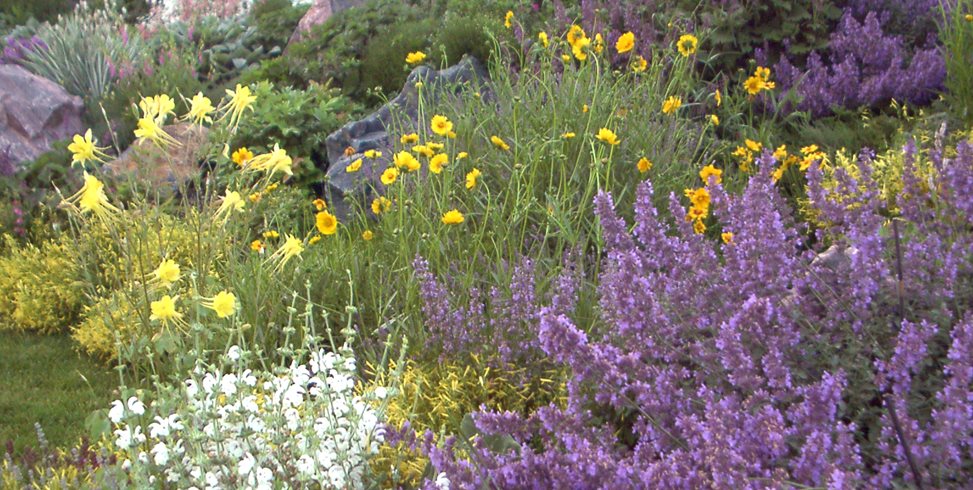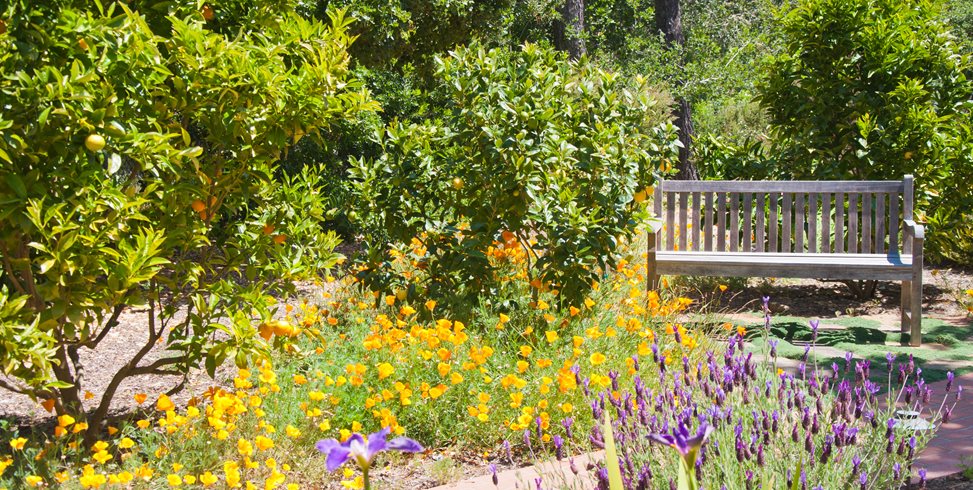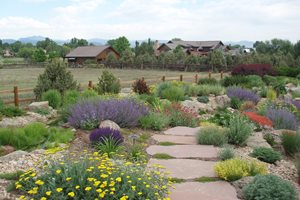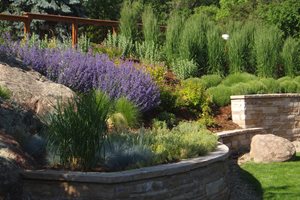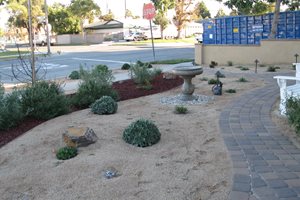Installing a Xeriscape
How to install a low-water xeric landscapeWith water becoming a limited resource, more and more people are choosing xeric landscapes, which aim to make the most of every drop of water that's used. Besides the obvious element of plant selection, your soil preparation, irrigation, materials, and even special finishing touches like water features or planters can all have an effect on how much or little water your landscape needs to thrive. Here, professional landscapers share their tips for installing a low-water xeriscape.
Grading and soil prep
Everything in the landscape starts with the soil. When the soil is graded and prepared properly, it can have as much effect on whether your xeriscape is successful as your plant selections. Here are some elements to keep in mind.
Direct the water through grading.
"I start by doing a grading plan for the yard so water doesn't flow out to the street," says Elizabeth Przygoda-Montgomery of Boxhill Landscape Design in Tucson, AZ. "The goal is to grade so water gently flows to the plants. It only takes a very slight angle to make the water move."
Make use of natural rainfall.
Rain barrels and rain storage tanks are an effective way of holding onto a seasonal influx of water. Though you'll need to make room for the storage tanks or dig them underground, "in terms of benefits to drawbacks you have to realize that this is free water that you're collecting," says Rama Nayeri of Creations Landscape Design in Tustin, CA. "Mother Nature gave it to you and you should take advantage of that generosity."
Don't miss your chance to add compost.
Once you add plants, landscape fabric, and mulch, it can be tough to get in and add compost to the soil, particularly if you need to use a rototiller to break up a hardpan layer. By adding compost at the beginning, you reap the benefits of increased moisture retention and decreased runoff.
Irrigation options
Even if you intend to water as little as possible once plants are mature, professionals agree that a drip irrigation system is a must in order to get plants established. "You can tell how garden is watered by its roots," says Greg Frugoli of Ecotones Landscapes in Cambria, CA. "Deep water encourages deep roots, which promotes the longevity of your plants and gives them the ability to withstand drought and stress." An irrigation system automates this process so plants get off to the right start.
Point source drip irrigation.
This is the traditional style of setting up a drip irrigation system, where each plant gets its own emitter at planting time. The advantage to point source drip irrigation is that absolutely no water is wasted, but the disadvantage is that it can be difficult for homeowners to add new plants to the system. In addition, as plants grow, they no longer use water that is directed at the central trunk of the plant, so point source drip irrigation systems should be updated every few years to make sure plants are able to benefit from the water you're providing. This style of irrigation is best when plants are placed farther apart.
Drip irrigation on a grid.
An irrigation brand called Netafim has popularized the use of drip irrigation on a grid layout. With this setup, emitters are placed every 12 inches throughout the landscape in a grid pattern. The advantage is that you get even water coverage over the entirety of the planting area, so it's easy for homeowners to add new plants, and the system will need little updating over time. The disadvantage is that you may end up watering areas of soil where you don't intend to plant anything, which is wasteful in a xeriscape and can promote weed growth. This style of irrigation is best for full planting schemes where total ground coverage is desired.
Hand watering.
Occasionally, retirees or those who work from home are able to water as deeply and regularly as an automated irrigation system would. Most landscapers are uneasy with this option due to past experiences with clients falling ill, going on vacation, or getting a new job which makes watering the landscape a lower priority. However, if you've planned for an exceptionally low-water landscape that will need watering only once or twice per month when mature, then hand watering just to establish the plants in the first two summers can be an effective option.
Dos and don'ts of choosing materials
Do remember that hardscaping becomes hot.
Stone, concrete, and pavers all radiate heat, so should be placed carefully within the design to allow trees and plantings to cool any reflected sun. Frugoli recommends using stepable groundcovers such as elfin thyme in between flagstones for a cooling effect.Don't cheap out when selecting materials.
"Use high-end materials for your hardscaping," says Frugoli. "Patios and seating areas will be a strong focus in a xeriscape, so you're going to notice whatever materials you choose."Do choose native plants whenever possible.
Not only are native plants adapted to your natural environment, but using them "makes you feel grounded and at home in the larger landscape," says Frugoli. "When using natives, you're not just building a collection of plants, you're building a sense of place."Don't buy materials from faraway places.
You already know that your local stone and other materials will hold up well under your own climate's quirks and extremes. Not only are local materials more cost effective, but they often last longer in the landscape.Do choose the right mulch for the right plant.
"In our area, mulches for very low-water plantings need to be stone," says Mike Woods of J&S Landscape in Longmont, CO. "Wood mulches hold too much moisture and can rot the base of many xeric natives." However, Woods points out that other types of garden plant like ornamental grasses, Rozanne Geranium, and catmint can all benefit from the water-holding capacity of wood mulch.
Finishing touches
In a xeric landscape, large stretches of lawn are often replaced with a small patio or seating area. This means that the decor you use to accent your landscape may take on greater importance in the design than in a traditional garden setting. Here's how to maximize your focal points and incorporate those designer touches which make the landscape sing.
Harmonize decor with plantings.
Pick up on the themes in your planting plan by repeating the colors of foliage and flowers in your paint selection, artwork, cushions, and sculpture. This helps all the areas of your landscaping feel integrated and well-planned.
Use a shallow-root planter to decorate walls or tables.
The tall, deep pots sold at most garden centers have a lot of wasted space if you are planting xeric plants. Xeric plants have shallower roots, and don't appreciate the standing water found at the bottom of most deep pots. A shallow, dish-shaped planter creates the perfect setting for succulents and other xeric plants to shine.
Add decadence with a water feature.
If you're concerned about your xeriscape garden looking dry, a water feature is a great way of bringing a sense of lush abundance to the garden. As a rule of thumb, the more surface area of water that is exposed to the air, the more water will evaporate, so choose fountains or water features that have an underground reservoir to reduce water use.

 Backyards
Backyards
 Front Yards
Front Yards
